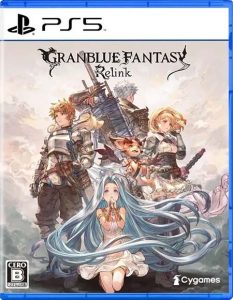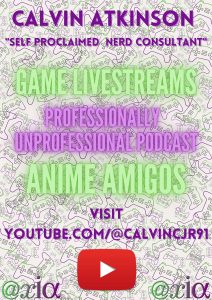Granblue Fantasy Relink
(available on PlayStation 5, PlayStation 4 and PC. PS5 used for this review.)
Granblue Fantasy is one of the most recognisable mobile gacha games currently ongoing. While the game is exclusive to Japan, it’s still insanely popular, receiving over 25 million downloads by 2019, getting a two-season anime, and celebrating its tenth anniversary this year. Despite that though, there has been a surprising absence of video games based on the franchise until recently.
In 2020 we had the release of Granblue Fantasy Versus, a fighting game based on the franchise which got a sequel in 2023 (which is featured at bloody EVO this year). And now we have Granblue Fantasy: Relink, a game that was announced back in 2016, but was hit with several delays and even had Platinum Games- who was co-developing the game- leave the project in 2019. It was developed by Cygames and finally released on 1st February 2024 for PlayStation 4, PlayStation 5, and Windows.
Story
Granblue Fantasy: Relink takes place in the same world as the original game, though a little further into the overall story (this is gonna get confusing if you don’t know Granblue Fantasy’s story, so hold on tight). The story follows a group of Skyfarers led by the Captain of the airship known as the Grandcypher, Gran, a young lad on a quest to find the realm of Estalucia. After fighting a band of monsters, forcing the captain and his companion Lyria to summon the dragon Bahamut who goes berserk and heavily damages the ship, they take a trip to the village of Folca for repairs. While there they meet Rolan, the priest of Folca going by the nickname Mr. Fix it (or as Vryn would call him, “Fix it Dude”), who offers to repair the Grandcypher and the crew decides to help him evacuate the residents of a village and subdue a Primal Beast attacking said village as thanks.
After stopping the Primal Beast Furycane, they are accosted by Lilith and the Church of Avia, who proclaim their intentions to capture Lyria and use her to reach Estalucia. The crew try to stop her and rescue Lyria but are countered by one of her allies, Id, and are swiftly defeated. It is now up to the Skyfarers of the Grandcypher to pursue the church, save Lyria, and put an end to Lilith’s plans.
The most I can say about the story is that it’s fine. It’s very fast-paced, to the point where it felt like little happened when I reached the game’s conclusion, but what was there was still enjoyable. It’s very apparent that the game expects you to have some basic knowledge of the main game’s story, as it tells you very little about the characters or the adventures that they’ve been on; aside from a couple of side characters, there isn’t really any kind of character development. Luckily it’s not so bad that you won’t enjoy what’s there or that you’ll be confused the entire time – in my case, my only experience with Granblue Fantasy is the first season of the anime from 2017 – but it’s still something that should be noted when playing.
Presentation
This is a very pretty game, environments are filled with vibrant colours that really pop out, and the use of lighting makes every inch of this game a feast for the eyes. This is the first time we’ve seen this cast as 3D models, and I can happily say that the transition was a complete success, the character models look fantastic in 3D and are perfect copies of their 2D counterparts.
I played the game in English dub and it’s about as good as you would expect an English dub for an anime game to be. The characters’ voices are over exaggerated slightly but never to the point of being grating and each character’s personality is exemplified with the actors’ performance. I especially love Maggie Robertson as Lilith, simply delightful.
The game’s soundtrack is very enjoyable. The song played in your hub area is peaceful and tranquil, while the battle music is loud and intense, and what’s played during boss fights is simply exquisite. Each song uses a variety of string instruments and sometimes choirs and is simply fantastic. This soundtrack has no right to be this damn good!
Level Design
The game’s levels are split into separate stages that can be accessed through the game’s hub areas. Story levels and some of the optional ones are very linear, essentially acting as pathways from one battle to another. Some of these levels are more open than others and will contain items for you to collect, though, at the end of the day, there is only one way forward. In these levels, you’ll come into contact with stones called Hallowed Ground, just by interacting with these you’ll heal up your party, but you can also use these spots to access services from the hub areas as well as save.
As for extra goodies, you may find some treasure chests along the way, some are out in the open and just require a bit of exploring, while others are a bit more hidden, requiring you to go through the trial of collecting a bunch of stones within the time limit before revealing itself.
A large number of stages, especially in the optional quests, will take place in some form of arena; basically, you’re thrown into a small open area and brawl against waves of enemies or a boss. These types of quests will involve you defending something, surviving until the timer runs out, or battling against multiple waves of opponents.
When not in these stages, you’ll spend your time in the small village of Folca or the grand city of Seedhollow. These hub areas are where you gain access to stages, both main and optional, as well as a bunch of other services such as the Blacksmith or Sierokarte’s Knickknack Shack.
Combat
Granblue Fantasy: Relink is an action JRPG, focused entirely on fighting groups of enemies and bosses with a heavy emphasis on teamwork. Combat seems very simple on the ground level, for most characters, it’s basically a button masher, but even then there’s a strange satisfaction to the game. It could just be because of the variety of characters and encounters, or because defeating large groups of enemies fuels the dopamine, but I found the combat to be surprisingly addicting. When I would have to repeat side quests because I didn’t get a rank I was satisfied with, I never found myself minding and even got excited a couple of times.
While the main character is the captain, and he does need to be in the party at all times, you do also have access to a decently sized cast of characters, half of which you’ll have access to from the start while others will require unlocking. Each character has an affinity with one of six types of elements, therefore most of their attacks will be based around that element. What I’m most surprised with is the versatility of each character, each character plays noticeably differently from one another, using different weapons and having different attack speeds, including entirely unique move sets for each of them; some being faster or slower than others, and some having a wider area of attack and others only really focusing on one enemy at a time.
Characters’ movements consist of a standard attack string as well as an attack that’s unique to them. It’s these unique attacks that really differentiate certain characters from one another.
While a lot of these unique moves may seem the same, certain aspects of them make the characters work differently from one another. As a couple of examples, Gran and Katalina both have the abilities to combine their unique attack and their standard to perform a unique combo finisher depending on where in the string the finisher takes place, however, unlike Gran, when Katalina performs a combo finisher, it builds up her Ares gauge, letting her perform greater combos once filled. For another, Io and Rackem both have attacks that require charging up, though Io’s covers a wider area, and Rackem’s charges up faster depending on how many standard attacks you perform. I think it’s amazing how this game manages to have characters that feel familiar, but have properties that make a slight difference on how you play as them. Considering the amount of characters there are in this game, the fact that they all play so differently is staggering.
Each character also has a variety of different skills that you unlock the further into their Masteries tree you go, some of these skills are similar to each other, some cast a barrage of projectiles from the sky, and some will lunge your character towards an enemy at a rapid speed, but each of these has different properties to one another, some causing status ailments or buffing your own stats for a short while, and will be slightly unique depending on the character who uses it. Once again, most of these skills will be of one of an element, most of the time the same one the character specialises in, meaning that they will be more effective against some enemies. There are of course some more defensive and non-aggressive moves as well, these basically equate to buffs for your characters, debuffs for your enemies, or healing moves.
One of the big features of this game is the Link Attacks. Enemies have a stun gauge that will increase as you consistently attack them. Once filled it will cause a Link Chance, where everyone in the party will get a prompt to perform a Link Attack. As you keep doing these, as well as performing other specific actions, your Link Level will rise. If everyone in your party performs a Link Attack when your Link Level is at 100%, Link Time will trigger. Link Time is an effect that grants you a great advantage, when in Link Time your enemies move slower, your attack increases and your skill cooldowns shorten significantly. I really like this mechanic, it greatly promotes teamwork between allies and you receive great benefits by doing so. (I’m pretty sure I just said Link more times in one paragraph than I did in my entire Tears of the Kingdom review).
My favourite mechanic in this game is the Skybound Arts, which are essentially the ultimate attack for your characters. Your Skybound Art gauge will increase as you deal and take damage, and once filled you’ll deal a super strong attack on whatever poor creature ends up in the vicinity of you. That’s not what I like about it though, whenever you or one of your allies performs this attack, it’ll increase the Skybound Art gauge for everyone else by 10%, letting more people be able to perform their attacks.
When multiple people have used their Skybound Arts within succession of another, a Chain Burst will trigger – an insanely powerful attack that will deal serious damage to an opponent of the element of whoever started the chain. The more Skybound Arts are used, the stronger the Chain Burst will be. I cannot stress how much I love this mechanic, once again it promotes the idea of teamwork and really makes you consider when the right time to use your Skybound Arts would be, making your party feel like a unit working together instead of separate warriors attacking the same foe.
Now the make or break with these kinds of games is the AI of your party members. While this game does have multiplayer co-op, there’s still a very likely chance that you’ll be playing this game primarily single-player, so in that case, it is essential that your allies actually be helpful. And thank the Astrals, your allies are incredibly useful! While not the best at avoiding attacks, I found them managing to get out of the way of powerful ones more often than not, they almost always know when to perform a Link Attack if able, and if their Skybound Arts gauge is filled they won’t do it straight away, instead, they’ll hold off until everyone can use it, giving you more of a chance to perform a Full Burst. I seriously cannot stress how good your companions are in a scrap, hell, oftentimes I’ll feel like the incompetent one of the group.
Character Progression
Of course, this is a JRPG, meaning that characters grow stronger by levelling up. Every time a character levels up, you’ll be rewarded with Mastery Points, which can be spent on a character’s Masteries tree to increase their stats, unlock new skills and ultimately make them better in combat. Characters don’t have individual Mastery Points, instead they all share a pool of them, meaning that you’ll have to decide not only what to spend the points on, but also who to spend the points on. Because of this, there are other ways of obtaining Master Points, like as rewards for certain quests, or by finding them in treasure chests.
On top of that, in both Folca and Seedhollow, you’ll have access to the Blacksmith, who will craft and upgrade your weapons to a higher level. You can even increase the level cap of your weapons here, all you need is the right materials and enough cash to do so.
Finally are the sigils, which will grant you extra effects depending on which ones you equip. Just like weapons, you can level these up at the Blacksmith to make their effects even greater.
Side Content
Surprisingly, there is quite a bit of side content to do. The side quests almost remind me of the hunts you go on in a Monster Hunter game, as you go to a counter where you receive these quests, and then are transported into a small area where these quests will take place.
As mentioned before, these quests involve different requirements for success, such as taking out a horde of enemies or defending an object or a bundle of objects, you’ll even find yourself facing off against bosses you fought in the story. In these you’ll also have several mini-objectives you can attempt as well, such as beating the quest in a certain time limit, having your crew go down only a certain number of times, or defeating a specific number of a certain enemy. At the end of the mission, you’ll receive a rank from C to S++ which is dictated by how well you did, how many enemies you defeated, how many of the bonus objectives you beat, and things like that. You’ll only get a few of these at first, but once you beat the main story, the amount of side content you get really expands and you’ll get more and tougher quests to do, giving you more content long after the main story ends.
The other type of side content is the Fate Episodes. It’s here that newcomers to the series will learn about the backstory of every character you play as, with each character having ten episodes total. These will include the character reading you their backstory, and occasionally a playable mission where you play as said character. You won’t be able to access all of these immediately, as a number of them will require that character to be at a certain level or for you to have reached a certain point in the game’s main story. Finishing each episode will give you an increase to that character’s health and attack. I’m a bit mixed on these if I’m honest, the playable missions are fun enough and it gives you a chance to try out characters you likely wouldn’t have before- hell, you might even find your new favourite through this- but the ones where you’re read the character’s backstory is kind of boring. I really would have preferred it if every episode was a playable mission, even if it meant we would get less of them.
Conclusion
This may sound weird but this was honestly one of the games I was most looking forward to this year, as I said I’ve had very limited experience with Granblue Fantasy, but this looked like a lot of fun. And I’m happy to say that it was even better than I thought it would be. I was not only surprised with how much fun the combat was, but also how I never got bored of it, and how this game incentivises teamwork above all else, even when playing single-player, makes me think about how good of a multiplayer game this is. There are going to be more updates to this game in the future, adding new content, including characters and bosses, and you better believe I’m gonna be keeping my eye out for it. Needless to say, I absolutely recommend this game, even if you’re not a fan of the series. It’s a ton of fun, and I’m looking forward to seeing what this game has next.
9.3/10
Anime Amigo and Nerd Consultant
Share This Post:








Leave a Reply